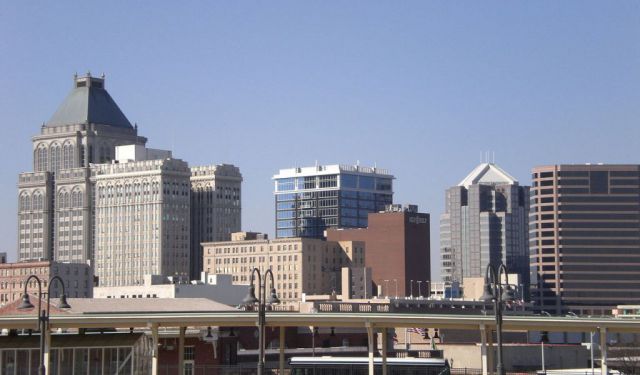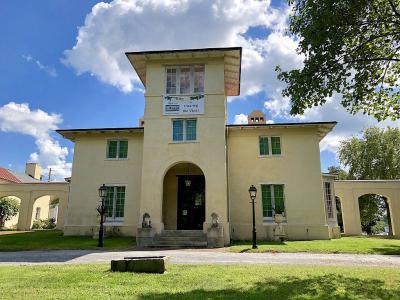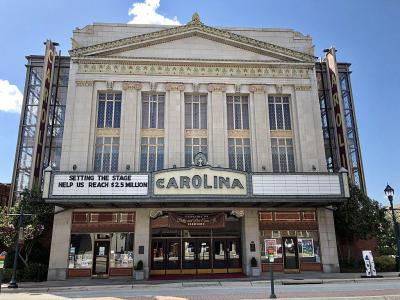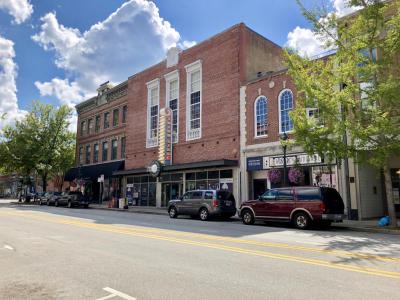
Greensboro Introduction Walking Tour (Self Guided), Greensboro
Before the arrival of Europeans in this part of North Carolina, the present-day area of Greensboro was inhabited by the indigenous (Siouan-speaking) Saura people, who called it "an unbroken forest with thick undergrowth of huckleberry bushes, that bore a finely flavored fruit."
Quaker migrants from Pennsylvania, by way of Maryland, arrived here in about 1750. They bought land from the Saura for their future village for just $98. The settlement grew rapidly and soon became North Carolina's most important Quaker community.
After the Revolutionary War, it was named “Greensboro” for Major General Nathanael Greene, commander of the rebel American forces at the Battle of Guilford Court House on March 15, 1781.
In the 1840s, Greensboro gained prominence as a pivotal stop on a new railroad line, earning the moniker "Gate City" for its role in transportation. This designation fueled the town's growth, facilitating trade and connecting it to markets. Despite a slow start, early wealth from the cotton trade spurred the construction of notable buildings such as Blandwood Mansion, designed by Alexander Jackson Davis.
During the American Civil War, Greensboro emerged as a significant site in the conflict's final chapters. Despite initial Unionist sentiments, it saw Confederate enlistment and endured the war's challenges.
In the aftermath of the war, Greensboro's textile industry underwent a revival. During the 1890s, large-scale textile plants transformed Greensboro into a bustling city, earning it the title of a Southern textile hub by 1900. The city's prosperity was reflected in the construction of notable civic architecture, including the Guilford County Courthouse and the West Market Street United Methodist Church. Throughout the 20th century, Greensboro experienced rapid population growth and economic development, even through the Great Depression.
In the 1960s, Greensboro reflected the racial tensions of the era. Black college students from North Carolina A&T sparked protests by sitting at Woolworth's "all-white" lunch counter. Today, the original lunch counter is part of the International Civil Rights Center and Museum.
The city's historical significance is palpable at every turn, with landmarks like the Greensboro Historical Museum offering a glimpse into its storied past. The Jefferson Standard Building stands tall as a symbol of Greensboro's economic prowess, while the Millennium Gate serves as a beacon of progress and innovation.
To acquaint yourself more fully with Greensboro as a city brimming with opportunities for discovery and adventure, take this self-guided walking tour. Greensboro awaits, ready to enchant and inspire!
Quaker migrants from Pennsylvania, by way of Maryland, arrived here in about 1750. They bought land from the Saura for their future village for just $98. The settlement grew rapidly and soon became North Carolina's most important Quaker community.
After the Revolutionary War, it was named “Greensboro” for Major General Nathanael Greene, commander of the rebel American forces at the Battle of Guilford Court House on March 15, 1781.
In the 1840s, Greensboro gained prominence as a pivotal stop on a new railroad line, earning the moniker "Gate City" for its role in transportation. This designation fueled the town's growth, facilitating trade and connecting it to markets. Despite a slow start, early wealth from the cotton trade spurred the construction of notable buildings such as Blandwood Mansion, designed by Alexander Jackson Davis.
During the American Civil War, Greensboro emerged as a significant site in the conflict's final chapters. Despite initial Unionist sentiments, it saw Confederate enlistment and endured the war's challenges.
In the aftermath of the war, Greensboro's textile industry underwent a revival. During the 1890s, large-scale textile plants transformed Greensboro into a bustling city, earning it the title of a Southern textile hub by 1900. The city's prosperity was reflected in the construction of notable civic architecture, including the Guilford County Courthouse and the West Market Street United Methodist Church. Throughout the 20th century, Greensboro experienced rapid population growth and economic development, even through the Great Depression.
In the 1960s, Greensboro reflected the racial tensions of the era. Black college students from North Carolina A&T sparked protests by sitting at Woolworth's "all-white" lunch counter. Today, the original lunch counter is part of the International Civil Rights Center and Museum.
The city's historical significance is palpable at every turn, with landmarks like the Greensboro Historical Museum offering a glimpse into its storied past. The Jefferson Standard Building stands tall as a symbol of Greensboro's economic prowess, while the Millennium Gate serves as a beacon of progress and innovation.
To acquaint yourself more fully with Greensboro as a city brimming with opportunities for discovery and adventure, take this self-guided walking tour. Greensboro awaits, ready to enchant and inspire!
How it works: Download the app "GPSmyCity: Walks in 1K+ Cities" from Apple App Store or Google Play Store to your mobile phone or tablet. The app turns your mobile device into a personal tour guide and its built-in GPS navigation functions guide you from one tour stop to next. The app works offline, so no data plan is needed when traveling abroad.
Greensboro Introduction Walking Tour Map






Guide Name: Greensboro Introduction Walking Tour
Guide Location: USA » Greensboro (See other walking tours in Greensboro)
Guide Type: Self-guided Walking Tour (Sightseeing)
# of Attractions: 9
Tour Duration: 2 Hour(s)
Travel Distance: 3.6 Km or 2.2 Miles
Author: Caroline
Sight(s) Featured in This Guide:
Guide Location: USA » Greensboro (See other walking tours in Greensboro)
Guide Type: Self-guided Walking Tour (Sightseeing)
# of Attractions: 9
Tour Duration: 2 Hour(s)
Travel Distance: 3.6 Km or 2.2 Miles
Author: Caroline
Sight(s) Featured in This Guide:
- Center City Park
- Greensboro Historical Museum
- Jefferson Standard Building
- Millennium Gate
- West Market Street United Methodist Church
- Blandwood Mansion
- Carolina Theatre
- Elm Street
- International Civil Rights Center & Museum
1) Center City Park
Center City Park stands as a beloved destination in Greensboro, offering a welcoming space for family entertainment and outdoor gatherings. Еhe park officially opened its gates in 2006 and has since become a focal point of community life. One of its standout features is the collection of stunning artworks created by talented local artists. From elegant fountains to captivating sculptures, pottery, metalwork, and granite and bronze benches, the park is adorned with a diverse array of artistic expressions that enhance its beauty and ambiance.
Center City Park stands as the vibrant epicenter of cultural life in the downtown area, encircled by an array of remarkable community amenities. These include the Steven Tanger Center for the Performing Arts, the Greensboro History Museum, the Greensboro Cultural Center, and the Greensboro Central Library. Additionally, the park is just a stone's throw away from downtown eateries, local shops, and other essential elements of the city's cultural landscape.
Beyond its artistic allure, Center City Park boasts meticulously landscaped grounds that contribute to its tranquil and inviting atmosphere. The lush greenery, vibrant flora, and well-maintained pathways create an ideal setting for leisurely strolls, picnics, and gatherings with loved ones. W
Center City Park stands as the vibrant epicenter of cultural life in the downtown area, encircled by an array of remarkable community amenities. These include the Steven Tanger Center for the Performing Arts, the Greensboro History Museum, the Greensboro Cultural Center, and the Greensboro Central Library. Additionally, the park is just a stone's throw away from downtown eateries, local shops, and other essential elements of the city's cultural landscape.
Beyond its artistic allure, Center City Park boasts meticulously landscaped grounds that contribute to its tranquil and inviting atmosphere. The lush greenery, vibrant flora, and well-maintained pathways create an ideal setting for leisurely strolls, picnics, and gatherings with loved ones. W
2) Greensboro Historical Museum (must see)
The Greensboro Historical Museum stands as a testament to the city's rich heritage, tracing back to its establishment in 1924. Housed within the historic confines of the former First Presbyterian Church, renowned for its Romanesque architectural style, this museum holds the distinction of being the city's oldest cultural institution. Boasting 15 galleries, visitors can embark on an immersive journey through the annals of Greensboro and Guilford County history. This expansive showcase offers insights into over 300 years of the region's evolution, providing a comprehensive overview of its cultural, social, and economic development.
Among the museum's diverse exhibitions, visitors can delve into a myriad of subjects, from the life and legacy of First Lady Dolley Madison to the iconic landmarks that define Greensboro as the "Gate City." Moreover, the museum's extensive collection encompasses the Murphy Confederate firearms collection, Zenke miniature rooms, and various other artifacts that offer glimpses into different facets of local and national history.
Additionally, guests can explore the Museum Shop, where they can peruse a curated selection of merchandise inspired by the museum's collections and exhibitions, ensuring that every purchase carries a piece of history.
Among the museum's diverse exhibitions, visitors can delve into a myriad of subjects, from the life and legacy of First Lady Dolley Madison to the iconic landmarks that define Greensboro as the "Gate City." Moreover, the museum's extensive collection encompasses the Murphy Confederate firearms collection, Zenke miniature rooms, and various other artifacts that offer glimpses into different facets of local and national history.
Additionally, guests can explore the Museum Shop, where they can peruse a curated selection of merchandise inspired by the museum's collections and exhibitions, ensuring that every purchase carries a piece of history.
3) Jefferson Standard Building
The Jefferson Standard Building stands tall as an iconic landmark in Greensboro, soaring to a height of 233 feet (71 meters). Completed in 1923, this majestic skyscraper served as the headquarters for the esteemed Jefferson Standard Life Insurance Company, now recognized as the Lincoln Financial Group. Boasting an impressive 18 floors, the building held the distinction of being the tallest in North Carolina until 1927, when it was surpassed by the Nissen Building in Winston-Salem. Moreover, during its heyday, it proudly held the title of the tallest structure between the vibrant cities of Washington, D.C., and Atlanta, Georgia, solidifying its status as a prominent fixture on the southeastern skyline.
Designed by the acclaimed architect Charles C. Hartmann of New York City, the Jefferson Standard Building is a masterpiece of architectural ingenuity and innovation. Julian Price, the visionary president of Jefferson Standard Life Insurance, entrusted Hartmann with the task of creating a headquarters that would reflect the company's prestige and values. Remarkably, Price financed the entire construction himself, adhering to his principle of avoiding debt. Inspired by the Equitable Building, the design of the Jefferson Standard Building incorporates a U-shape layout, facilitating the penetration of natural light and fresh air throughout the interior spaces.
The exterior facade of the Jefferson Standard Building is a captivating fusion of architectural styles, blending elements of Neo-Gothic, Neo-Classical, and Art Deco influences. Constructed primarily of terra cotta and granite, the building exudes timeless elegance and sophistication. Notable features include a terra cotta tile facade adorned with Beaux-Arts and Romanesque motifs, as well as a striking bust of Thomas Jefferson, after whom the company was named. Symbolic Buffalo nickels flank the ground floor windows, serving as emblems of thrift and economy.
Designed by the acclaimed architect Charles C. Hartmann of New York City, the Jefferson Standard Building is a masterpiece of architectural ingenuity and innovation. Julian Price, the visionary president of Jefferson Standard Life Insurance, entrusted Hartmann with the task of creating a headquarters that would reflect the company's prestige and values. Remarkably, Price financed the entire construction himself, adhering to his principle of avoiding debt. Inspired by the Equitable Building, the design of the Jefferson Standard Building incorporates a U-shape layout, facilitating the penetration of natural light and fresh air throughout the interior spaces.
The exterior facade of the Jefferson Standard Building is a captivating fusion of architectural styles, blending elements of Neo-Gothic, Neo-Classical, and Art Deco influences. Constructed primarily of terra cotta and granite, the building exudes timeless elegance and sophistication. Notable features include a terra cotta tile facade adorned with Beaux-Arts and Romanesque motifs, as well as a striking bust of Thomas Jefferson, after whom the company was named. Symbolic Buffalo nickels flank the ground floor windows, serving as emblems of thrift and economy.
4) Millennium Gate
The Millennium Gate stands as a striking testament to Greensboro's rich history and cultural heritage, captivating both residents and visitors alike since its unveiling in 2002. Situated at the Municipal Office Building on West Washington Street, this magnificent bronze sculpture was masterfully crafted by renowned local artist Jim Gallucci. Rising approximately 20 feet tall, the Millennium Gate commands attention with its imposing presence, adorned with a center rotating piece measuring about 6 feet wide and 14 feet tall.
As a symbol of the city's evolution and progress over the past millennium, the Millennium Gate is adorned with an array of intricate icons representing pivotal events, inventions, and figures that have left an indelible mark on Greensboro. Each icon serves as a poignant reminder of the city's vibrant history and contributions to various fields. For instance, the inclusion of a chair pays homage to Greensboro's esteemed furniture industry, which has played a significant role in shaping the local economy. Additionally, the Statue of Liberty serves as a poignant symbol of the profound impact of immigration on the United States, reflecting Greensboro's diverse and inclusive spirit.
As a symbol of the city's evolution and progress over the past millennium, the Millennium Gate is adorned with an array of intricate icons representing pivotal events, inventions, and figures that have left an indelible mark on Greensboro. Each icon serves as a poignant reminder of the city's vibrant history and contributions to various fields. For instance, the inclusion of a chair pays homage to Greensboro's esteemed furniture industry, which has played a significant role in shaping the local economy. Additionally, the Statue of Liberty serves as a poignant symbol of the profound impact of immigration on the United States, reflecting Greensboro's diverse and inclusive spirit.
5) West Market Street United Methodist Church
Steeped in history and architectural splendor, West Market Street United Methodist Church stands as a cherished landmark in Greensboro. Erected in 1851, this iconic church boasts a distinguished design characterized by the Richardson Romanesque style, which is renowned for its grandeur and intricate detailing. Over the years, the church has undergone several renovations and enhancements, further solidifying its status as a cornerstone of the community.
A notable feature of West Market Street United Methodist Church is its exquisite stained glass windows, which were added in 1893 and sourced from Chicago. These windows add a touch of elegance and artistry to the church's interior, casting colorful hues of light that create a serene and reverent ambiance. Additionally, the church underwent a significant renovation in recent years, during which additional buildings were constructed and the magnificent Dobson-Rosales organ was installed, further enhancing the church's musical offerings and architectural allure.
Among the church's most treasured attributes are the Via Dolorosa paintings dating back to the 1890s. These paintings depict the biblical journey of Jesus Christ to the cross, known as the "Way of Sorrows" or "Way of the Cross," and hold deep symbolic significance for worshippers. Revered for their historical and artistic value, these paintings serve as a poignant reminder of the church's enduring commitment to faith, community, and spiritual enlightenment.
A notable feature of West Market Street United Methodist Church is its exquisite stained glass windows, which were added in 1893 and sourced from Chicago. These windows add a touch of elegance and artistry to the church's interior, casting colorful hues of light that create a serene and reverent ambiance. Additionally, the church underwent a significant renovation in recent years, during which additional buildings were constructed and the magnificent Dobson-Rosales organ was installed, further enhancing the church's musical offerings and architectural allure.
Among the church's most treasured attributes are the Via Dolorosa paintings dating back to the 1890s. These paintings depict the biblical journey of Jesus Christ to the cross, known as the "Way of Sorrows" or "Way of the Cross," and hold deep symbolic significance for worshippers. Revered for their historical and artistic value, these paintings serve as a poignant reminder of the church's enduring commitment to faith, community, and spiritual enlightenment.
6) Blandwood Mansion (must see)
Originally constructed in 1795 as a modest four-room Federal style farmhouse, Blandwood Mansion underwent significant transformation under the ownership of two-term North Carolina governor John Motley Morehead. Notably, Blandwood Mansion is revered as the oldest building in Greensboro built on its original foundations, bearing witness to the city's evolution from rural surroundings to urban development.
Renowned architect A. J. Davis, inspired by Tuscan villas despite never having visited Italy, crafted a stunning design for Blandwood Mansion in 1844. Davis's vision included wide overhanging eaves, low rooflines, casement windows, stucco-on-brick veneer, and a distinctive tall prospect tower dominating the facade. The mansion stands as a rare example of grand antebellum architecture in the Piedmont region of North Carolina, contrasting with the area's predominantly agricultural landscape and small enslaved population.
Preservation Greensboro Incorporated, a local nonprofit dedicated to historic preservation, acquired Blandwood Mansion in 1966, recognizing its architectural and historical significance. Subsequent efforts focused on meticulous restoration, including paint analysis, archaeological investigations, reconstruction of dependencies, and restoration of surrounding gardens. The mansion's interior was enriched with original furnishings returned by members of the Morehead family, further enhancing its authenticity and charm.
Today, Blandwood Mansion stands as a testament to the antebellum spirit of improvement, earning its place on the National Register of Historic Places in 1970 and designation as a National Historic Landmark in 1988.
Renowned architect A. J. Davis, inspired by Tuscan villas despite never having visited Italy, crafted a stunning design for Blandwood Mansion in 1844. Davis's vision included wide overhanging eaves, low rooflines, casement windows, stucco-on-brick veneer, and a distinctive tall prospect tower dominating the facade. The mansion stands as a rare example of grand antebellum architecture in the Piedmont region of North Carolina, contrasting with the area's predominantly agricultural landscape and small enslaved population.
Preservation Greensboro Incorporated, a local nonprofit dedicated to historic preservation, acquired Blandwood Mansion in 1966, recognizing its architectural and historical significance. Subsequent efforts focused on meticulous restoration, including paint analysis, archaeological investigations, reconstruction of dependencies, and restoration of surrounding gardens. The mansion's interior was enriched with original furnishings returned by members of the Morehead family, further enhancing its authenticity and charm.
Today, Blandwood Mansion stands as a testament to the antebellum spirit of improvement, earning its place on the National Register of Historic Places in 1970 and designation as a National Historic Landmark in 1988.
7) Carolina Theatre
The Carolina Theatre has stood as a beacon of entertainment since its construction in 1927. Initially renowned for its grand vaudeville performances and silent movies accompanied by a majestic organ, the theater boasted a seating capacity of 2,200 during its heyday. However, tragedy struck in the 1980s when a fire ravaged the building, leading to its reconstruction without the balcony. Despite this setback, the Carolina Theatre persevered, emerging as a resilient symbol of the city's cultural heritage.
Today, the Carolina Theatre continues to captivate audiences with its diverse repertoire of offerings. With a seating capacity now reduced to 1,100, the theater maintains its commitment to providing a vibrant cultural experience for the community. Its program includes screenings of classic and art films, electrifying concerts featuring renowned artists, and captivating performances by local theater and dance groups. This eclectic mix of events ensures that the Carolina Theatre remains a dynamic hub of artistic expression, attracting approximately 100,000 spectators annually.
Today, the Carolina Theatre continues to captivate audiences with its diverse repertoire of offerings. With a seating capacity now reduced to 1,100, the theater maintains its commitment to providing a vibrant cultural experience for the community. Its program includes screenings of classic and art films, electrifying concerts featuring renowned artists, and captivating performances by local theater and dance groups. This eclectic mix of events ensures that the Carolina Theatre remains a dynamic hub of artistic expression, attracting approximately 100,000 spectators annually.
8) Elm Street
Elm Street in downtown Greensboro holds a special place in the city's history as a vibrant center of commerce and social activity. One of its notable landmarks is the International Civil Rights Center & Museum, located just off Elm Street, which commemorates the historic sit-in protests at the Woolworth's lunch counter in 1960. This museum offers visitors a poignant glimpse into the struggle for civil rights and the pivotal role Elm Street played in shaping the nation's history.
In addition to its historical significance, Elm Street boasts a diverse array of shops and boutiques, making it a prime destination for shopping enthusiasts. From unique gift shops to trendy boutiques and bookstores, Elm Street offers something for every taste and preference. Visitors can explore eclectic establishments like Glitters, Just Be, Scuppernong Books, and Terra Blue, each offering a distinctive shopping experience that adds to the street's charm.
Elm Street is also home to various cultural attractions, including Elsewhere, a quirky art museum housed in a former thrift store. This museum showcases eclectic objects from around the world and features an artist residency program that fosters creativity and innovation. Nearby, Natty Greene's Downtown brewery offers a welcoming atmosphere where visitors can enjoy a variety of craft beers and Southern-inspired dishes. Additionally, the Ambleside Gallery, located on Elm Street, showcases a diverse selection of art from England and Europe, providing art enthusiasts with an opportunity to admire exceptional works from talented artists.
With its blend of history, shopping, and cultural attractions, Elm Street stands as a vibrant and dynamic destination in downtown Greensboro.
In addition to its historical significance, Elm Street boasts a diverse array of shops and boutiques, making it a prime destination for shopping enthusiasts. From unique gift shops to trendy boutiques and bookstores, Elm Street offers something for every taste and preference. Visitors can explore eclectic establishments like Glitters, Just Be, Scuppernong Books, and Terra Blue, each offering a distinctive shopping experience that adds to the street's charm.
Elm Street is also home to various cultural attractions, including Elsewhere, a quirky art museum housed in a former thrift store. This museum showcases eclectic objects from around the world and features an artist residency program that fosters creativity and innovation. Nearby, Natty Greene's Downtown brewery offers a welcoming atmosphere where visitors can enjoy a variety of craft beers and Southern-inspired dishes. Additionally, the Ambleside Gallery, located on Elm Street, showcases a diverse selection of art from England and Europe, providing art enthusiasts with an opportunity to admire exceptional works from talented artists.
With its blend of history, shopping, and cultural attractions, Elm Street stands as a vibrant and dynamic destination in downtown Greensboro.
9) International Civil Rights Center & Museum (must see)
The International Civil Rights Center & Museum holds significant historical importance as it occupies the former Woolworth's building, where the historic Greensboro sit-ins commenced on February 1, 1960. The museum's primary objective is to commemorate the courageous actions of four students from North Carolina Agricultural and Technical State University, alongside other individuals who participated in the Woolworth's sit-ins and the broader civil rights movement across the nation.
Established on February 1, 2010, precisely 50 years after the pivotal sit-in protests, the International Civil Rights Center & Museum serves as a poignant reminder of the struggle for racial equality and justice. Architect Charles Hartmann designed the building in an elegant art deco style, adding to its historical significance. Originally completed in 1929 as the Whelan Building, it was predominantly occupied by the Whelan Drug Co. Woolworth later relocated to the site in 1939, setting the stage for the momentous events that unfolded within its walls.
The museum offers visitors a profound and immersive journey through the annals of American history, shedding light on the bravery and resilience of those who fought against racial segregation and discrimination. Through interactive exhibits, multimedia presentations, and curated collections, the museum provides invaluable insights into the civil rights movement's impact on society and its enduring legacy.
Established on February 1, 2010, precisely 50 years after the pivotal sit-in protests, the International Civil Rights Center & Museum serves as a poignant reminder of the struggle for racial equality and justice. Architect Charles Hartmann designed the building in an elegant art deco style, adding to its historical significance. Originally completed in 1929 as the Whelan Building, it was predominantly occupied by the Whelan Drug Co. Woolworth later relocated to the site in 1939, setting the stage for the momentous events that unfolded within its walls.
The museum offers visitors a profound and immersive journey through the annals of American history, shedding light on the bravery and resilience of those who fought against racial segregation and discrimination. Through interactive exhibits, multimedia presentations, and curated collections, the museum provides invaluable insights into the civil rights movement's impact on society and its enduring legacy.
Walking Tours in Greensboro, North Carolina
Create Your Own Walk in Greensboro
Creating your own self-guided walk in Greensboro is easy and fun. Choose the city attractions that you want to see and a walk route map will be created just for you. You can even set your hotel as the start point of the walk.
Greensboro Downtown Statues and Monuments Walk
The birthplace of renowned author O Henry, Greensboro, North Carolina, also holds the distinction of harboring the genesis of the American Civil Rights Movement. Both these facts are commemorated in public artwork. Other esteemed personalities and notable chapters in the city's history also find reflection in a plethora of monuments and statues throughout Downtown.
Among these landmarks,... view more
Tour Duration: 2 Hour(s)
Travel Distance: 2.7 Km or 1.7 Miles
Among these landmarks,... view more
Tour Duration: 2 Hour(s)
Travel Distance: 2.7 Km or 1.7 Miles
The Most Popular Cities
/ view all










